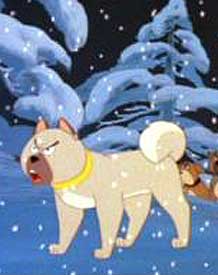 The famous story of the Brave 47 Ronin, aka Chushingura, is Japan's most important historical tale of revenge & self-sacrifice among the samurai. It has been filmed scores of times, with a few versions moving away from the historical setting in unusual ways.
The famous story of the Brave 47 Ronin, aka Chushingura, is Japan's most important historical tale of revenge & self-sacrifice among the samurai. It has been filmed scores of times, with a few versions moving away from the historical setting in unusual ways.
Among other oddest versions of Chushingura we may count Daisaku Shirakawa's animated Wanwan Chushingura (Bow Wow Chushingura aka Doggy March aka Watchdog Woof Woof, Toei, 1963) with stray dogs in the role of the brave 47 ronin.
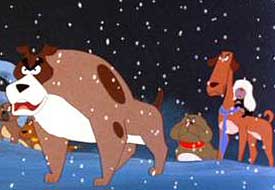 It's the story of feral dogs out to avenge their slain alpha female against a tiger named Killer. The strays are led by Rock, who was a puppy when his mother was slain but has grown to an age that he must undertake the revenge. It's the story of feral dogs out to avenge their slain alpha female against a tiger named Killer. The strays are led by Rock, who was a puppy when his mother was slain but has grown to an age that he must undertake the revenge.
This was the first film on which Hayao Miyazaki worked as an animator. He has gone on to become internationally renoun for such animated features as Spirited Away.
Tokuzo Tanaka's Noga-dosu Chushingura (Long Daggers of Chushingura, Daiei, 1962) transposes the Genroku era samurai revenge tale to the world of Bakumatsu era yakuza. A chivalrous gamblers' oyabun or godfather while trying to assist trod-upon peasants is arrested & executed by corrupt official.
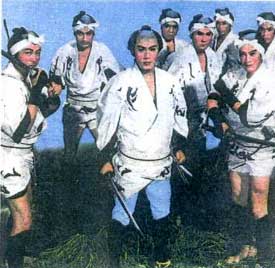 The rest of the tale unveils the preparations & final revenge raid by 47 brave commoners led by the young yakuza Horinouchi no Kisaburo (Raizo Ichikawa). Shintaro Katsu puts in an appearance as a samurai lord who approves of the revenge. The rest of the tale unveils the preparations & final revenge raid by 47 brave commoners led by the young yakuza Horinouchi no Kisaburo (Raizo Ichikawa). Shintaro Katsu puts in an appearance as a samurai lord who approves of the revenge.
Among gunplay yakuza films, one is of special interest to viewers more commonly on the lookout for martial arts rather than fire arms. Gang Chushingura aka Chushingura Outlaws or The Story of 47 Loyal Gangsters (Gyangu Chushingura, Toei, 1963) in two parts chronicles almost scene for scene the Brave 47 Ronin story, transposed from the Genroku Period to the modern or Showa Era.
It has sometimes been regarded as the eighthepisode of the loosely thought of Gyangu series that began with Hana to arashi to gyanyu (Toei, 1961) & ended with the eleventh episode Gyangu no teio (1967). But this was only nominally a series & did not have recurring characters.
Appearing immediately before the rise of ninkyo-eiga or chivalrous yakuza films as a major commercial force, it is interesting that the medieval tale of Chushingura should be chosen as the expression of yakuza idealism before the idea of noble yakuza was fully jelled at Toei Studios. One or two years later this choice would've been more expected, after the Chivalrous Gambler was in full sway with one or more heroic gangster in the theater houses every week.
A year or two later it would've had plenty of swordfighting rather than gunplay, too, as the ninkyo variety of gangster film commonly climaxed in swordplay mayhem. I963 was the last year wherein the cinamatic expectation was that gangsters had shoot-outs instead of swordfights.
For those of us who prefer swordplay, we can lament that Gangyu Chushingura didn't hold off production just a little while so that someone would've realized it needed to not only be a modernized samurai story in the yakuza world, but swords did not have to be replaced with guns.
Chivalrous yakuza films deal in great part with the worship of manliness & the worship of revenge in the context of dutiful valor, really no different than more standard tellings of Chushingura. So the famous tale transposes to the gangster world fairly smoothly.
The trailer boasted whimsically, "Shocking sights in hotel lobbies!" The most shocking thing about the lobby turned out only to be that it is a replica of the kabuki stage & cinematic set whereon Asano Naganori (1667-1701) draws his swordsword against the insulting Kira Yoshinaka inside Edo Castle, a breach of ettiquette that results in Lord Asano having to commit seppuku.
Gangster Asano of Kyushu is played by Ken Takakura, who for the following decade would be the biggest of all chivalrous yakuza stars. Asano draws his gun in the above-mentioned hotel lobby & wings the boss of Kira Enterprises, a man in league with an American gangster intent of distributing heroin in Japan.
Imprisoned for the attempt on Kira's life, Asano is soon poisoned by Kira's minions before Asano's men can get him released. Thereafter, Chiezo Kataoka becomes the focal character, Oishi, named for Oishi Yoshio (1659-1703) who led the historical 47 ronin. Yakuza lieutenant Oishi leads 47 gangsters in revenge for their murdered oyabun godfather or boss.
In the key climactic scene of Part II, the brave gangsters close in on the house of Kira & his men with blazing, smoking handguns flashing. It's less satisfying than the usual Genroku display of sword, spear, & naginata action, but it's still curiously moving even in this absurd context.
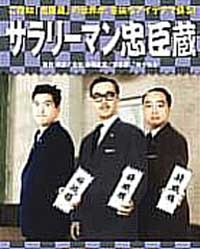 An inadvertently satiric film, it nevertheless boasts an impressive cast. Koji Tsuruta is the 48th Comrade, a legionaire helped by Boss Asano on a trip to Paris. Shinichi Chiba is a young, tough brawler. So Yamamura is Tachibana the police chief friend to Oishi the leader of revenge plan. Tetsuo Tamba, Ryunosuke Tsukigata, Eitaro Shindo, Eijiro Yanagi, Yoshiko Mita & Yoshiko Sakuma are a few of the actors in Gangyu Chushingura. To Chushingura completists this film will have distinct charm. An inadvertently satiric film, it nevertheless boasts an impressive cast. Koji Tsuruta is the 48th Comrade, a legionaire helped by Boss Asano on a trip to Paris. Shinichi Chiba is a young, tough brawler. So Yamamura is Tachibana the police chief friend to Oishi the leader of revenge plan. Tetsuo Tamba, Ryunosuke Tsukigata, Eitaro Shindo, Eijiro Yanagi, Yoshiko Mita & Yoshiko Sakuma are a few of the actors in Gangyu Chushingura. To Chushingura completists this film will have distinct charm.
Toshio Sugie's Salaryman Chushingura parts I & II (Sarariman Chushingura, 1960; & Zoku sarariman chushingura, Toho, 1961) is a reworking of the classical story, turning the 47 ronin into modern office workers, so that guys enslaved to depressing jobs can feel good about the fact that it's killing them.
Oishi leader of the brave 47 office workers is played by Hisaya Morishige. Sad-eyed Ryo Ikebe is Asano. It's peppered with well known players including Toshiro Mifune, Takashi Shimura, Daisuke Kato, Michiyo Aratama, Tatsuya Mihashi, Keiki Kobayashi "& many other stars."
copyright © by Paghat the Ratgirl
|
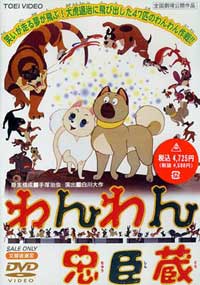

 It's the story of feral dogs out to avenge their slain alpha female against a tiger named Killer. The strays are led by Rock, who was a puppy when his mother was slain but has grown to an age that he must undertake the revenge.
It's the story of feral dogs out to avenge their slain alpha female against a tiger named Killer. The strays are led by Rock, who was a puppy when his mother was slain but has grown to an age that he must undertake the revenge. The rest of the tale unveils the preparations & final revenge raid by 47 brave commoners led by the young yakuza Horinouchi no Kisaburo (Raizo Ichikawa). Shintaro Katsu puts in an appearance as a samurai lord who approves of the revenge.
The rest of the tale unveils the preparations & final revenge raid by 47 brave commoners led by the young yakuza Horinouchi no Kisaburo (Raizo Ichikawa). Shintaro Katsu puts in an appearance as a samurai lord who approves of the revenge. An inadvertently satiric film, it nevertheless boasts an impressive cast. Koji Tsuruta is the 48th Comrade, a legionaire helped by Boss Asano on a trip to Paris. Shinichi Chiba is a young, tough brawler. So Yamamura is Tachibana the police chief friend to Oishi the leader of revenge plan. Tetsuo Tamba, Ryunosuke Tsukigata, Eitaro Shindo, Eijiro Yanagi, Yoshiko Mita & Yoshiko Sakuma are a few of the actors in Gangyu Chushingura. To Chushingura completists this film will have distinct charm.
An inadvertently satiric film, it nevertheless boasts an impressive cast. Koji Tsuruta is the 48th Comrade, a legionaire helped by Boss Asano on a trip to Paris. Shinichi Chiba is a young, tough brawler. So Yamamura is Tachibana the police chief friend to Oishi the leader of revenge plan. Tetsuo Tamba, Ryunosuke Tsukigata, Eitaro Shindo, Eijiro Yanagi, Yoshiko Mita & Yoshiko Sakuma are a few of the actors in Gangyu Chushingura. To Chushingura completists this film will have distinct charm.